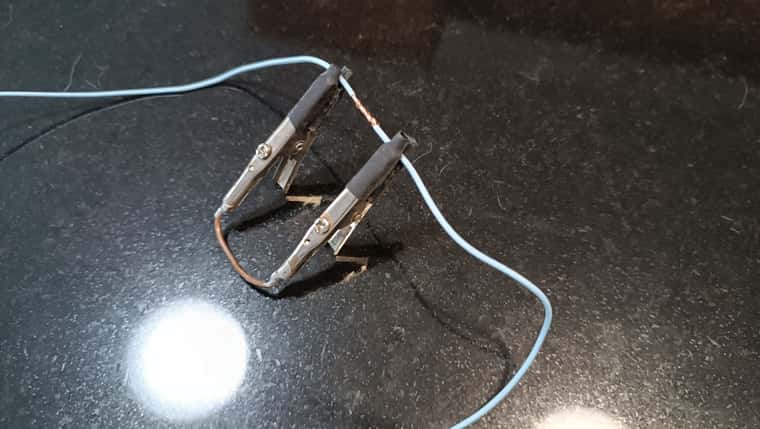how to join wires together?
-
I feel a bit like I'm declaring I don't know how to tie my own shoelaces / clean my teeth / dress myself, but how to tidily join wires?
Suppose you've bought an extruder from Aliexpress and when it arrives it turns out to have stupid-short (60mm) wires on the stepper and you don't want a dangling plug and socket block there, so you want to extend the wires. (Entirely hypothetically, obviously.)
I mean, in principle, strip the insulation, solder the ends, add heatshrink. However, it doesn't ever seem to work as easily as that for me. Soldering the ends of two wires together seems unreasonably awkward and they drift apart or I end up with a solder blob about five times bigger than I think it should be. If I try and twist the wires together they unravel when I apply the iron. I think I could make it work if I had four hands (at least two of which are heat-proof), but even using my 'helping hands' jigs it doesn't go as well as I'd like.
I have sometimes crimped them into opposite ends of a cut-down bootlace ferrule, which can be quite tidy.
Is there a better way?
-
@achrn I think soldering is best. When soldering wires together, I tend to do a 'Lineman splice' - https://en.wikipedia.org/wiki/Western_Union_splice. You strip off more insulation than you expect, then bend the wires around each other tightly, a bit like tying a fisherman's bed in rope, before soldering (not forgetting the heatshrink). The twisted joint stays together a bit easier, so you can put each side in the helping hands without it coming apart. There are plenty of guides around.
There are also low temperature solder sleeves, which are a bit easier to use, and seems to be what NASA likes to use: https://workmanship.nasa.gov/lib/insp/2 books/links/sections/407 Splices.html. That also shows crimped splices. Or Wago connectors, if you want to stay away from soldering irons, but I haven't tried them.
Ian
-
@achrn get something like this to hold the wires as you hold the soldering iron with one hand and the solder with the other.
I typically put a single bend in each wire and hook them together, squeezing the bends tight, then solder, then shrink the tubing over them. Never fails.
Wagos are great, but they're big- not the sort of thing you want dangling from your extruder carriage. They are great for wiring the rest of the printer...
-
I Twist & solder using a clamp i made myself

-
@droftarts @mrehorstdmd Thanks both,
I think it was the hooking them round step that I was missing - I've just done four with the lineman splice (which also starts hooking them round) and much better.
I do have one of those things to hold the wires - in fact I have two - a cheap one, and when the cheap one didn't work as well as I wanted an expensive one in case it was the tool's fault (it wasn't).
I do like Wagos for many things, but not hanging off the printhead.
-
@achrn In the example you cite, best practice IMO would be to actually use an inline connector. You don't really want a soldered joint in a flexible connection (joint becomes brittle), and a nice connector at the end of pigtail means easy swapping of components (upgrades? replacing a bad motor?).
For chassis wiring, soldering would work well - the solder sleeves mentioned above are pretty awesome. https://www.newark.com/c/cable-wire-cable-assemblies/cable-management/sleeving-tubing/solder-sleeves
-
@achrn I use solder sleeves. I shrink/solder them using hot air from a SMD rework station, but I'm told that it can be done using a cigarette lighter. They are available on Amazon, e.g. in the UK at https://www.amazon.co.uk/gp/aw/d/B073RMRCC3?th=1. I mostly use the white (small size) ones.
Caution: some of these are not RoHS compliant so they can't be used in products to be sold, at least in the UK and EU.
-
My big secret is to tin the wires first. After stripping the wires, apply some flux so the solder will stick easily and tin the wires. I like flux pens like these: https://www.amazon.com/Soldering-Electronics-Tabbing-Welding-Maintenance/dp/B0953NGKXR. TInning without flux is a big pain. And the pens are great for working on PC boards if you do that.
Once both side have been tinned, the two sides will stick quickly. And use heat shrink tubing.
Not quite related, but if you expect the wires to be flexed at all during use, I highly recommend silicone insulated wires. The insulation is flexible and usually the strands of the wire are very fine so the whole thing will be flexible. https://www.amazon.com/BNTECHGO-Silicone-Flexible-Stranded-Tinned/dp/B09X45RZCQ It's not super cheap, but after debugging two cases of thermistor wires broken inside a cable chain I decided to take the plunge and I'll never use the cheapo stranded stuff again.
Lastly, a good soldering iron is a good investment. I have one like this that I like: https://www.amazon.com/dp/B07Z3KCVCL
PS - and get a little tub of tip-tinner to refresh the tip of your soldering iron when it becomes hard to melt the solder on it. https://www.amazon.com/Thermaltronics-FBA_TMT-TC-2-Lead-Tinner-Container/dp/B00NS4J6BY